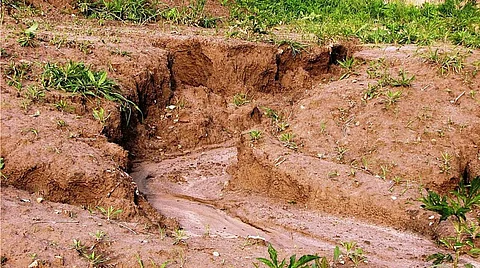
- Topics
- Feature
- Opportunities & Events
- About
- Hindi Portal
- Data
- Topics
- Feature
- Opportunities & Events
- About
- Hindi Portal
- Data

Gully erosion is increasing the severity of land degradation in India.
What are gullies?
A gully is a common landform system found in mountainous and hilly areas and is formed by surface erosion as a result of temporary water flows. It can however get drastically eroded due to flow of concentrated amounts of surface and /or subsurface runoff forming open, unstable channels that have been cut more than 30 centimetres deep into the ground, causing severe land degradation.
Gully erosion is the most destructive form of land erosion
Gully erosion stands out from other types of soil erosion in terms of depth and intensity of erosion and has a negative impact on soil quality, depletes the landscape of carbon and heavy metal storage, decreases crop yields and biomass, affects water quality, reduces reservoir storage capacity, alters catchment hydrological functioning and brings about drastic land use changes.
Prolonged gully erosion can lead to creation of badlands or degraded lands
Prolonged and intense gully erosion can lead to creation of Badlands – terrains with clay-rich soil and soft sedimentary rocks eroded by wind and water. Badlands do not have any vegetation as they have steep slopes, no loose material and there is no soil formation.
In India, badlands account for the majority share of gullied area and are associated with poor socio-economic conditions as they lead to reduced agricultural productivity, water scarcity, droughts leading to migration and fragmented landscapes.
Earlier gully mapping exercises in India involved identification of badlands as areas to be rehabilitated and reclaimed and badlands management was a national policy priority. However, there is no accurate information on the current spatial distribution and severity of gully erosion in India beyond the regions affected by the badlands. This paper titled 'Gully erosion is a serious obstacle in India’s land degradation neutrality mission' published in Nature, Scientific Reports presents the findings of a study that aimed at creating the first detailed spatial inventory of gully erosion in India.
The study finds that:
Gully erosion is extensive in India
Gully erosion changes are found in 19 of India’s 28 states and the National Capital Region (NCR) of Delhi. A total of 51,755 gully erosion features were identified across 286 districts located within these provinces. The total gully erosion affected area in India is estimated to be between 7,451 and 8,157 km2.
Gully erosion is concentrated in the states of Rajasthan, Uttar Pradesh, Madhya Pradesh, Jharkhand, Gujarat and Chhattisgarh. While the total area of these states is 38 percent of Indian territory, they account for a staggering 92 percent of the total land area affected by gully erosion in the country.
The features of gully erosion differ by regions
Badlands are predominantly located in the states of Rajasthan, Uttar Pradesh, Madhya Pradesh and Gujarat in Western and Central India.
Gully erosion and denuded hillslopes in eastern India are concentrated in the states of Jharkhand, Bihar, Odisha and Chhattisgarh.
Gully erosion in the eastern states though significant continues to be ignored
While the extent of gullied land has been found to be higher in the badlands regions of Western and Central India, the absence of any land management practices in a significant portion of gully systems in many eastern districts of Madhya Pradesh and across the eastern states of Bihar, Jharkhand, Chhattisgarh, Odisha, and West Bengal is worrying. In as many as 80 districts within this eastern region of India, more than a quarter of the identified gully erosion features are not managed.
Gully erosion in the eastern and southern regions needs attention
Management of gully erosion needs to be prioritised in a total of 77 districts across the country. Ten districts across Rajasthan, Uttar Pradesh and Madhya Pradesh need urgent management despite long-term land reclamation operations in the past.
When the overall district-wise gully management priority of the states is considered, the eastern states of Jharkhand and Chhattisgarh rank on the top of the list, followed by Madhya Pradesh and Rajasthan.
Although previous research has almost completely overlooked gully erosion in Southern India, the study finds that several southern districts, especially in the state of Tamil Nadu, require urgent land management intervention to tackle the problem.
Gully erosion in eastern India poses a higher challenge to achieving land degradation neutrality in India as compared to central and western India
The study finds that gully erosion in Eastern India poses a more serious impediment to land degradation neutrality in India than the badlands of Central and Western India. However, improper badlands reclamation practices have led to detrimental environmental, ecological and socioeconomic impacts and call for the need to have appropriate badlands rehabilitation initiatives in regions where they are predominant.
Land management policies in India need to focus on gully erosion and recognise differences between badlands and gullies
India urgently needs a land management policy that not only shows an appreciation for the overall scale of its gully erosion problem, but also recognises the fundamental differences between badlands and gullies in terms of geomorphology and evolutionary dynamics as well as the range of their social and environmental impact.
An agroforestry policy formulated in 2014 constitutes one of the cornerstones of India’s LDN mission. There is a need for a complementary land management policy, which outlines a strategy to find solutions to remedy various types of land degradation, including gully erosion.
However, considering that gully erosion rates are expected to increase further due to higher rainfall intensities induced by climate change, gully rehabilitation should be accorded maximum importance in India’s LDN plans, argues the paper.